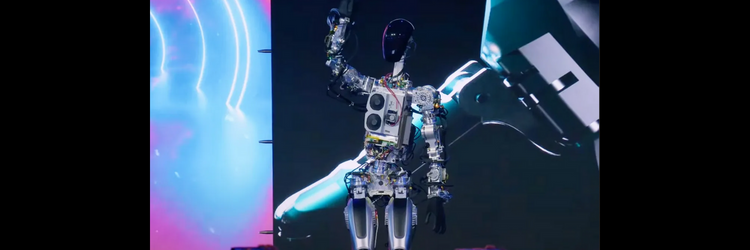by Jon Gabay, Engineer
The Optimus robot, also known as Teslabot, was unveiled recently at the electric vehicle maker’s AI day with optimism. Tesla CEO Elon Musk made the point that his goal is to introduce humanoid-like robots as quickly as possible at high volumes and low costs, following the philosophy of the electric cars his company Tesla manufactures.
Watching the video, I could only think that it resembled a constipated C3PO as it slowly and cautiously walked across the presentation stage. While it did not resemble the artist’s depictions of what Optimus would be, it was humanoid in shape, a bipedal electric vehicle by strict definition, and it walked, maintaining its balance, not an easy task.
While disappointing to many, I am looking more at the bigger picture. Any early technology is clumsy and clunky when first introduced. It takes several generations before the streamlining occurs. This is certainly the case here.
The demonstrations included removing metal bars from a box and placing them on an assembly line and Optimus walking across the floor to deliver a parcel to a workstation desk. These actions are easily programmed tasks performed without AI and with basic robotic and processor-based hardware.
The key will be the brains of the machine. It is unclear at this time what the brain of Optimus can do. We have yet to see the touted AI making the robot learn and adapt in action. This is akin to the self-driving technology car makers promised that isn’t yet delivered due to technical challenges and problems.
But, the journey of a thousand miles begins with a single step. And Optimus is not yet prime. If Optimus’s deep learning capability is effective, it can achieve a myriad of valuable tasks, marking the beginning of learning machines replacing humans for mundane, simple, and repetitive actions. This has already occurred with programmed machines like assembly line robots, pick and place robots, painting station robots, and other examples.
However, while robots can replace humans for these mundane tasks, it causes an issue that we must address. These robots will replace many workers, from factory assembly line employees to burger flippers in restaurants to migrant farm workers in the fields to bartenders. I wonder how good Optimus will be at listening to a patron’s troubles as they mix up a drink.
We use language to teach humans and programming machines. When robots like Optimus become available, we will also teach them with language. When a human can tell Optimus what they want Optimus to figure out, and when Optimus can use trial and error learning to master a task, that will be a milestone.
The demonstration at the show did not show Optimus talking or listening to spoken commands. Perhaps future demonstrations will, hopefully, in an effective and useful way. Robots that are truly flexible enough to offload human tasks without preprogramming will engender assistant robots that can help on the factory floor and in homes and facilities.
I can see the “almost $20,000” Optimus taking over janitorial functions like mopping a floor and dusting in the near future. Maybe even doing the dishes and laundry after that. After all, the largest market segment will be for home and apartment use, especially as the population ages.
The question is, will robots like Optimus allow humanity to be creative in a new golden age, or just get fat sitting on a couch? I want to see a new golden age of art and culture, but I fear future generations of couch potatoes.
What did you think of Optimus? Will robots become ubiquitous? Will you welcome our robot overlords? Or will they eventually end up like Skynet?

